[概念理解] UML类建模
Class Diagram
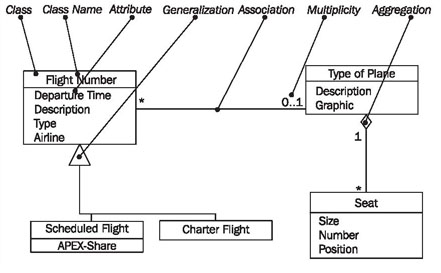
In class diagrams, as shown in Figure 4.30, we work with the following elements:
Class
A class represents a relevant concept from the domain, a set of persons, objects, or ideas that are depicted in the IT system:

Examples of classes are passengers, planes, or tickets.
Attribute
An attribute of a class represents a characteristic of a class that is of interest for the user of the IT system:

Characteristics of interest of a passenger, for example, are name and age.
Generalization
Generalization is a relationship between two classes: a general class and a special class:

Refer to Generalization, Specialization, and Inheritance.
Association
An association represents a relationship between two classes:

An association indicates that objects of one class have a relationship with objects of another class, in which this connection has a specifically defined meaning (for example, "is flown with").
Multiplicity
A multiplicity allows for statements about the number of objects that are involved in an association:

Also see Figure 4.32.
Aggregation
An aggregation is a special case of an association (see above) meaning "consists of":

The diamond documents this meaning; a caption is unnecessary.
Reading Class Diagrams
Figure 4.31 shows a class diagram from our case study with the classes customer, ticket, and coupon, their attributes, and their associations:

Looking at the class diagram in Figure 4.31, you can read the association between the classes customer and ticket as follows:
- One (this sentence always begins with "one") object of the first class has an association with a number of objects of the second class.
The appropriate values from the diagram have to be inserted into this first abstract formulation, which can be universally applied. The name of one class is customer (1); the name of the other class is ticket (4). The name of the association is owns (2):
- A customer (1) owns (2) * (3) ticket (4).
If the asterisk is exchanged with its meaning, a regular English sentence is created:
- A customer (1) owns (2) zero, one or several (3) ticket(s) (4).
Since associations usually are not directional, meaning usually go both directions, our association also has a meaning in the other direction:
- A ticket (4) is owned by (2) exactly one (5) customer (1).
The small triangle next to the name of the association (2) indicates in which direction the name of the association holds true. We can read all the associations in the class diagram in this way.
The specification of the number of objects of the second class (you always start with one object of the first class) is called the multiplicity. The course of action should always be according to the same pattern:
First, a statement of the lower limit (minimum number) followed by two periods (..) and a statement of the upper limit (maximum number).
Figure 4.32 shows the most common possibilities:
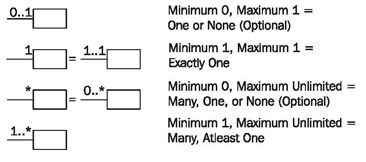
However, in UML it is also possible to insert any values as the lower and upper limits, e.g., 2 .. 4 or 6 .. *.
The association's name is necessary for understanding the domain meaning of the association. In contrast to the association itself, which applies to both directions, the name of the association applies to only one direction, which is indicated by a black triangle. If the association is not labeled, its meaning has to be derived from the domain context, or it takes on a general meaning such as has or belongs to. In case of doubt it is better to label associations too much than too little. Many diagrams that we have encountered in our practical experience were incomprehensible because associations were not labeled.
Associations can also be viewed as the implementation of static business rules (see Static and Dynamic Business Rules). Statements such as "a ticket belongs to exactly one customer" are documented in the class diagram by associations.
Roles are another possible way in UML to give relationships between classes a domain meaning. In this way, we can state what role an object of one class plays for the objects of another class:
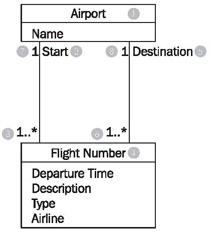
Looking at the class diagram in Figure 4.33, we can read the left association with roles between the classes flight number and airport as follows:
- An airport (1) is a start (location) (2) for one or more (3) flightnumbers (4).
There is another association between the two classes flight number and airport:
- An airport (1) is a destination (5) for one or more flight numbers (4).
These two associations also have inversions, even though roles are only stated for one direction:
- A flight number (4) has as start (location) (2) exactly one (7) airport (1).
- A flight number (4) has as destination (5) exactly one (8) airport (1).
This records that a certain flight number has a departure airport and a destination airport. An example of a flight number is LX317, a daily flight of the Swiss airline Crossair from London to Zurich.
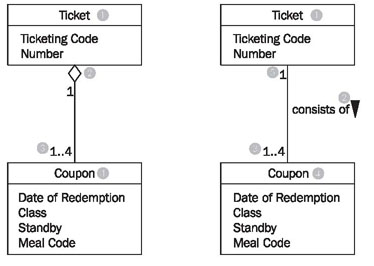
Among the many domain meanings that an association can have there is one that can be signified with UML by its own symbol: the whole-part relationship or aggregation. This type of relationship is always used when objects of one class are a part of objects of another class.
In the class diagram in Figure 4.34 aggregation is used on the left side (the white diamond), which can be read as follows:
- A ticket (1) consists of (2) 1 to 4 (3) coupons (4).
or the other way around:
- A coupon (4) is part of (2) exactly one (5) ticket (1).
The example without a diamond, but with a name for the association, has exactly the same meaning! The last missing element of UML that we use to model class diagrams is generalization/specialization, which serves to depict the relationship between a superclass and a subclass. The generalization/specialization in Figure 4.35 can be read from top to bottom or bottom to top. If you begin at the top, you find a class Freight (1) with the attributes: Identification, Weight, and ID-number (2). This class has two specializations, Piece of Luggage (3) and Piece of Cargo (4). The class Piece of Cargo has an additional attribute: Degree of Hazardousness (5).
If you begin at the bottom you will find the classes Piece of Luggage (3) and Piece of Cargo(4). These have a superclass, the class Freight (1), which contains the shared attributes (and functions) of the subclasses.
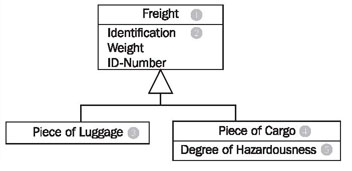
[概念理解] UML类建模的更多相关文章
- UML类建模(强烈推荐-思路很清晰)
UML类建模(强烈推荐-思路很清晰) 2016年10月23日 15:17:47 mbshqqb 阅读数:2315 标签: uml面向对象设计模式 更多 个人分类: 面向对象程序设计 UML的构造快 ...
- UML类图关系大全
UML类图关系大全 1.关联 双向关联: C1-C2:指双方都知道对方的存在,都可以调用对方的公共属性和方法.在GOF的设计模式书上是这样描述的:虽然在分析阶段这种关系是适用的,但我们觉得它对于描述设 ...
- UML类图关系大全【转】
UML类图关系大全 1.关联 双向关联:C1-C2:指双方都知道对方的存在,都可以调用对方的公共属性和方法. 在GOF的设计模式书上是这样描述的:虽然在分析阶段这种关系是适用的,但我们觉得它对于描述设 ...
- Java 大黑话讲解设计模式 -- UML类图
目录 1.啥是UML类图? 2.UML类图有啥用? 3.正式理解UML类图 4.使用idea画第一个UML类图 5.类之间的关系图[必须牢记] 6.类之间的关系 6.1.依赖 6.2.泛化 6.3.实 ...
- UML类图关系全面剖析
UML的类图关系分为: 关联.聚合/组合.依赖.泛化(继承).而其中关联又分为双向关联.单向关联.自身关联:下面就让我们一起来看看这些关系究竟是什么,以及它们的区别在哪里. 1.关联 双向关联:C1- ...
- UML类图关系-转
1.关联 双向关联: C1-C2:指双方都知道对方的存在,都可以调用对方的公共属性和方法. 在GOF的设计模式书上是这样描述的:虽然在分析阶段这种关系是适用的,但我们觉得它对于描述设计模式内的类关系来 ...
- UML类图关系大全-转
1.关联 双向关联: C1-C2:指双方都知道对方的存在,都可以调用对方的公共属性和方法. 在GOF的设计模式书上是这样描述的:虽然在分析阶段这种关系是适用的,但我们觉得它对于描述设计模式内的类关系来 ...
- UML类图关系表示
UML 之 C++类图关系全面剖析 分类: 软件设计与架构2008-10-16 08:52 5165人阅读 评论(3) 收藏 举报 umlc++borderclasscblog UML的类图关系分为: ...
- 我对uml类图关系的理解
uml类图的关系: 泛化关系也就是继承. 实现关系就是一个类实现另外一个接口. 依赖关系就是一个类使用了另外一个类,是一种使用关系,在这个类的某个服务中需要另外一个类来协助. 关联关系就是一类拥有另外 ...
随机推荐
- 【详●析】[GXOI/GZOI2019]逼死强迫症
[详●析][GXOI/GZOI2019]逼死强迫症 脑子不够用了... [题目大意] 在\(2\times N\)的方格中用\(N-1\)块\(2\times 1\)的方砖和\(2\)块\(1\tim ...
- sin_addr.s_addr和sin_addr.S_un.S_addr
sin_addr.s_addr和sin_addr.S_un.S_addr 先mark一下,等下写
- phpStrom+xdebug调试php
1>xdebug下载 1.1>xdebug官网可以根据phpinfo()源代码来提供对应版本的xdebug,地址:https://xdebug.org/wizard.php 如下截图 1. ...
- 学习PyQuery库
学习PyQuery库 好了,又是学习的时光啦,今天学习pyquery 来进行网页解析 常规导入模块(PyQuery库中的pyquery类) from pyquery import PyQuery as ...
- 剑指Offer(书):二叉树的下一个节点
题目:给定一个二叉树和其中的一个结点,请找出中序遍历顺序的下一个结点并且返回.注意,树中的结点不仅包含左右子结点,同时包含指向父结点的指针. 分析:若一个节点有右子树,那么他的下一个节点就是他右子树中 ...
- Python 爬虫从入门到进阶之路(三)
之前的文章我们做了一个简单的例子爬取了百度首页的 html,本篇文章我们再来看一下 Get 和 Post 请求. 在说 Get 和 Post 请求之前,我们先来看一下 url 的编码和解码,我们在浏览 ...
- POJ3037 Skiing
Skiing 题目大意: 给定一个M*N的网格,已知在每个网格中的点可以向上下左右四个方向移动一个单位,每个点都有一个高度值. 从每个点开始移动时存在一个速度值,从A点移动到B点,则此时B点的速度为& ...
- UVA11090 Going in Cycle!! 【SPFA】
题意:求一个无向图的边权平均值最小的环 思路:假设环中Σwi/t<ans 那变形一下就是Σwi<ans*t → Σ(wi-ans)< 0 这样就可以二分答案做了 #include & ...
- 洛谷P1771 方程的解_NOI导刊2010提高(01)
题目描述 佳佳碰到了一个难题,请你来帮忙解决. 对于不定方程a1+a2+…+ak-1+ak=g(x),其中k≥2且k∈N,x是正整数,g(x)=x^x mod 1000(即x^x除以1000的余数), ...
- java中filter的用法
filter过滤器主要使用于前台向后台传递数据是的过滤操作.程度很简单就不说明了,直接给几个已经写好的代码: 一.使浏览器不缓存页面的过滤器 Java代码 import javax.servlet ...
